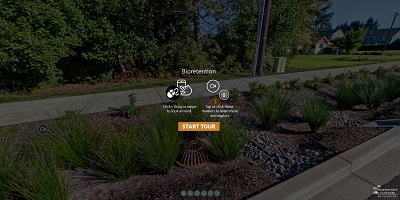Bioretention (rain garden)
Bioretention facilities, also called rain gardens, use engineered soils and specific plants to trap and uptake pollutants in stormwater. Often located along roads and in parking lots, bioretention cells also store stormwater, which is meant to drain within 48 hours. Excess stormwater overflows to an adjacent drainage system. Treated water is either infiltrated into the underlying native soil or collected by an underdrain and discharged to drywells or surface water.
Routine maintenance throughout the year is necessary to keep your bioretention cells functioning properly. Maintaining plants, soil, and mulch helps ensure optimum infiltration, storage and pollutant removal capabilities. The majority of routine maintenance procedures are typical landscape care activities that can be performed with common tools.
Where to find it:
Bioretention cells are typically found along roads and in parking lots. There can be multiple cells throughout a neighborhood or in a parking lot.
When to maintain it:
Remove sediment and clear curb cuts in late fall and early spring. Remove weeds and water new plants throughout the summer and early fall. Water new plants for the first three summers. Remove weeds and clear litter and debris throughout the year as needed.
What you'll need:
- rake
- bucket lined with trash bags
- gloves
- safety equipment (cones, high visibility clothing, etc.) if working near traffic
You many also need a shovel, mulch, replacement plants and water for irrigation.
Tools you'll need:
Before:
After:
Bioretention cells needs maintenance in these areas:
Weeds
Identify what is a weed and what plants are
meant to be there. Pull weeds early before
they go to seeds.
Plants
Replace dead plants from fall to spring and water during the first three summers. Contact your local jurisdiction for a list of approved plants.
Mulch
Maintain 3 inches of mulch to help with plant survival. Arborist mulch is effective, low cost and may be required by your jurisdiction.
Trash and debris
Clear trash and debris as needed.
Overflow
Ensure the overflow is clear from debris.
Maintenance is needed if you see these signs
Bare, exposed soil without mulch cover
Pest infestations, including rodent holes or mounds that disturb water dispersion flow paths and damaged vegetation
Large amounts of pet waste
Inlets or outlets clogged with leaves, trash or sediment
Water ponding for more than 48 hours after the end of a storm
Erosion around inlets, outlets and on slopes
Sediment buildup, usually near inlet
Unhealthy or dead vegetation
Blackberries or other problem vegetation
Diseased or dead vegetation
Leaves, trash and other debris













